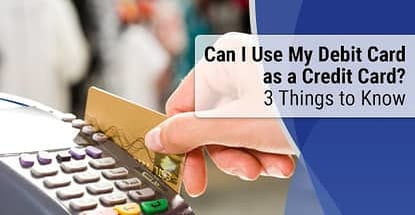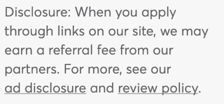For the longest time, when I was making a purchase and the “credit” or “debit” option appeared on the terminal screen, I quietly wondered, “Can I use my debit card as a credit card?” I would never ask the sales clerk though. I assumed it was common knowledge I had somehow missed out on learning. But that wasn’t exactly the case.
Leave it to banks to overcomplicate the issue. Giving consumers a debit card and then providing the option to choose “credit” or “debit” without explaining why is definitely unnecessarily confusing.
There are distinct differences between these two types of transactions — and they are important to know. Below are a few things you should understand about these transactions so you can make the right choice. We’ll dive into exactly what the word “credit” means as it relates to debit cards and how using the debit option could lead to more fees.
1. “Credit” Doesn’t Mean Pay Later
First of all, let’s discuss the misleading nature of the word “credit” in relation to your debit card. Selecting this option at the time of purchase does not suddenly turn your debit card into a line of credit you can borrow from.
So, although you can choose “credit” when purchasing something with your debit card, you cannot use your debit card the same way you would a credit card.
When you select credit, rather than the transaction going through in real time as it does with a debit card, the transaction happens offline. Once the merchant batches their receipts and reconciles them with the credit card company, then your charge goes through. This can take roughly two to three days.
So the charge may not necessarily be removed from your account that day, but it will be removed in a few days. Whereas with a credit card, you get a bill each month and you decide how much to pay. When you swipe a debit card and choose “credit,” the full amount of the purchase will eventually be pulled from your bank account.
2. “Debit” is Like Using an ATM and May Include Fees
Since the money is leaving your account either way (rather than when you pay a credit card bill), it may seem easier to just use the “debit” option. However, there could be a fee to do this. The fee isn’t a lot (less than a quarter per transaction), but if you swipe your card on a day-to-day basis, those fees can start adding up.
When you swipe your card and choose debit, you’ll be asked to enter your PIN. Most banks do not charge a fee for inputting your PIN, but it’s important to check with your financial institution beforehand. This is just like withdrawing money from an ATM. Make sure you have the funds available for your purchase amount at the time of purchase, or else you could end up overdrawing your bank account.
If you want a no-fee way to make purchases — along with payment flexibility and added security — a credit card with no annual fee or a 0% introductory APR may be the way to go.
Top 3 No Annual Fee Cards
The following three cards have no annual fee and are excellent options for those with good credit (generally a credit score above 700).
This card is currently not available. Additional Disclosure: The information related to Chase Freedom Flex℠ credit card has been collected by CardRates.com and has not been reviewed or provided by the issuer of this card.1. Chase Freedom Flex℠
Another nice feature of these cards is the associated rewards programs. You can earn cash back, air miles, or points toward merchandise and travel you wouldn’t otherwise receive by using a debit card. A few financial institutions offer debit card rewards, but they’ve been harder to come across since the 2008 financial crisis.
Top 3 Introductory 0% APR Cards
The following cards charge no interest on purchases for the duration of the introductory period, providing cardholders a very forgiving repayment plan — just be sure to pay your balance before the intro period ends.
Additional Disclosure: Bank of America is a CardRates advertiser. Additional Disclosure: Bank of America is a CardRates advertiser. Additional Disclosure: Bank of America is a CardRates advertiser.
3. Selecting “Credit” Can Make It More Challenging to Track Your Budget
Since credit transactions take a few days to process, it’s important to keep track of your transactions daily. If you don’t and you end up relying on your account balance instead, you could be in for a huge surprise in a few days.
This is really important because of one thing: overdraft fees. If your account goes negative, you could be charged upward of $35 for every single transaction that goes through after you hit a negative balance. It only takes a few swipes of the card to dip your account several hundred dollars in the red. This can be avoided if you sign up for overdraft protection, in which case those negative transactions go through to a line of credit. However, there are still small fees for this (nowhere near as high as overdraft fees, though).
Even if you keep track of your budget every day, make sure you do so with your receipts. If you rely on the transactions you can see online, you’re going to be looking at some weird numbers. For example, gas stations might only authorize $1 at the time of purchase to make sure your card works. Or some might charge $50-$100 to cover the potential cost of your charge. A restaurant may also overcharge since they have to leave room for you to add your tip at the end.
In all of these instances, the charges will be reconciled in a few days. But a lot of damage can be done in those few days if you’re not keeping track of your balance based on your receipts.
How to Choose Between “Credit” and “Debit”
If you’re left wondering what the best option is after all this, the answer really just depends on your lifestyle. If you’re a master budgeter and would rather not enter your PIN every time you make a purchase, then choosing credit is a fine option. But if you don’t trust yourself to track your receipts daily, debit is the better way to go.
And if safety is your biggest concern of all, then the question comes down to whether you should even use a debit card. While the new chip and pin technology is a major improvement for security, using a card that has any access to your bank account could have more hazardous effects on your finances than swiping a real credit card that only has access to a line of credit.
For my part, I prefer to use my debit card at the ATM only. Then I use cash for most purchases and a credit card if I have to. That way, if a fraudulent transaction happens, the money in my bank account is still protected. And finally, I make sure to pay my credit card online when I make these transactions, ensuring that I don’t have to deal with interest charges or fall into debt.
Advertiser Disclosure
CardRates.com is a free online resource that offers valuable content and comparison services to users. To keep this resource 100% free, we receive compensation for referrals for many of the offers listed on the site. Along with key review factors, this compensation may impact how and where products appear across CardRates.com (including, for example, the order in which they appear). CardRates.com does not include the entire universe of available offers. Editorial opinions expressed on the site are strictly our own and are not provided, endorsed, or approved by advertisers.


![3 FAQs: ATM Card vs. Debit Card vs. Credit Card ([updated_month_year]) 3 FAQs: ATM Card vs. Debit Card vs. Credit Card ([updated_month_year])](https://www.cardrates.com/images/uploads/2016/05/atm-card-vs-debit-card-vs-credit-card--1.png?width=158&height=120&fit=crop)
![7 Things to Know About the Discover Debit Card ([updated_month_year]) 7 Things to Know About the Discover Debit Card ([updated_month_year])](https://www.cardrates.com/images/uploads/2023/11/7-Things-to-Know-About-the-Discover-Debit-Card.jpg?width=158&height=120&fit=crop)
![4 Best Online Bank Accounts With Instant Debit Cards ([updated_month_year]) 4 Best Online Bank Accounts With Instant Debit Cards ([updated_month_year])](https://www.cardrates.com/images/uploads/2023/10/The-Best-Online-Bank-Accounts-With-Instant-Debit-Cards.jpg?width=158&height=120&fit=crop)
![9 Best Debit Cards With No ATM Fees ([updated_month_year]) 9 Best Debit Cards With No ATM Fees ([updated_month_year])](https://www.cardrates.com/images/uploads/2023/10/Best-Debit-Cards-With-No-ATM-Fees.jpg?width=158&height=120&fit=crop)
![6 Best Reloadable Debit Cards ([updated_month_year]) 6 Best Reloadable Debit Cards ([updated_month_year])](https://www.cardrates.com/images/uploads/2023/11/7-Best-Reloadable-Debit-Cards.jpg?width=158&height=120&fit=crop)
![7 Best No-Fee Debit Cards ([updated_month_year]) 7 Best No-Fee Debit Cards ([updated_month_year])](https://www.cardrates.com/images/uploads/2023/11/best-no-fee-debit-cards.jpg?width=158&height=120&fit=crop)
![7 Best Prepaid Debit Cards for Bad Credit ([updated_month_year]) 7 Best Prepaid Debit Cards for Bad Credit ([updated_month_year])](https://www.cardrates.com/images/uploads/2019/08/shutterstock_609135914-edit1.jpg?width=158&height=120&fit=crop)
![9 Best Prepaid Debit Cards For Minors ([updated_month_year]) 9 Best Prepaid Debit Cards For Minors ([updated_month_year])](https://www.cardrates.com/images/uploads/2021/04/Best-Prepaid-Debit-Cards-For-Minors.jpg?width=158&height=120&fit=crop)